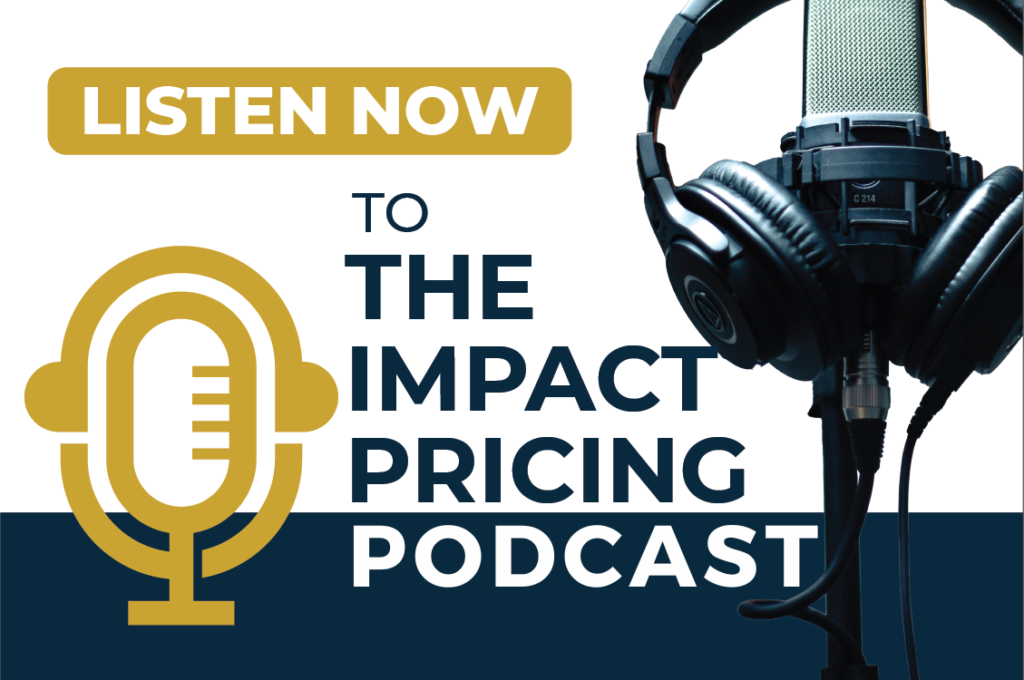Emanuel Martonca, founder of Soft Fight, reveals how agentic AI is solving one of the biggest challenges in IT services: coordinating pricing decisions across hundreds of people in decentralized organizations.
After his career journey from product management to sales management to discovering pricing at a Simon Kucher workshop, Emanuel shares how his bootstrapped company evolved from traditional consulting to building AI-powered pricing agents that act as an ever-present pricing manager- coaching teams, improving proposals, and recommending pricing models without sending a single byte of data outside the client’s infrastructure.
In this episode, learn why AI should augment rather than replace pricing teams, why deterministic calculations still matter, and how to quantify value in IT services without universal quality standards.
Podcast: Play in new window | Download
Why you have to check out today’s podcast:
- Discover how AI solves coordination problems in large IT services companies where hundreds of people make pricing decisions without pricing expertise.
- Learn why AI should augment pricing teams, not replace them, and why deterministic calculations still matter more than probabilistic AI outputs.
- Understand how to quantify value in IT services using measurable quality attributes instead of universally accepted standards.
“Pricing is leverage. It allows you to have an impact with very few actions, with little effort.“
– Emanuel Martonca
Topics Covered:
01:32 -Emanuel’s transformational discovery of pricing at a Belgian retail bank workshop that revealed a world he didn’t know existed—launching 18 years of pricing-focused work.
02:37 – Why pricing is the ultimate leverage tool, especially in B2B tech where “it’s just communication”—what you write in Excel, on websites, and in proposals.
03:28 – How the pandemic transformed Emanuel from a globe-trotting sales manager into a pricing consultant, then bootstrapped Soft Fight to solve the value extraction gap in tech companies.
04:41 – How large IT companies lose money when hundreds of non-experts across five functions (finance, marketing, sales, delivery, executives) make pricing decisions on every custom project.
06:59 – The evolution from deterministic SaaS pricing rules to AI-augmented agents installed in client infrastructure—solving pricing problems in hours instead of years without sending data externally.
08:00 – Why new deals lack technical depth and renewals lack value articulation—and how AI coordinates knowledge without restructuring organizations.
11:00 – Eight AI agents (four for understanding, four for justifying) with access to all systems but zero external communication—no security or privacy risks.
13:00 – All pricing calculations remain deterministic because AI makes too many mistakes—it’s used only for reading RFPs, emails, and meeting notes to improve value communication.
14:17 – How AI acts as a coach recommending pricing models with ready-made arguments, eliminating months of change management—with email as the main interface.
16:17 – Why determining “how long will this take?” is unpredictable and varies by person and timing—and how AI solves the costliest unknown in custom projects.
18:00 – Mark’s perspective on why costs matter less than value, and why companies avoid alternative pricing models despite knowing hourly billing hurts both sides.
21:00 – When AI tools cut development time, hourly pricing becomes self-defeating: “You’re cutting your own revenue”—forcing the industry to finally sell value, not time.
21:56 – Starting with measurable quality attributes on invented scales that competitors can’t compare—getting 80% of the way just by having the quantification discussion.
23:00 – Mark’s framework for B2B value and why results translate to economic impact through customer KPIs like reduced complaints, not abstract “quality” metrics.
25:00 – Unlike automotive suppliers with nanometer specs, IT services vendors can define their own quality metrics—putting them two steps ahead of alternatives.
26:00 – The necessity of industry knowledge for value conversations (increase revenue, reduce costs, mitigate risk) and how AI enables understanding of new sectors that would’ve taken years.
27:30 – Final Advice: AI as Your Pricing Force Multiplier Using AI for research, analysis, and domain understanding when teams are too small or mandates unclear—plus how to connect with Emanuel on LinkedIn.
Key Takeaways:
“AI is a huge multiplier for pricing experts—not for calculating prices, I agree with you on that, it’s not there yet. But for everything else around pricing, whether we want to call it product management, analysis, or research, it can help us overcome typical challenges.” – Emanuel Martonca
“Pricing is a change management problem. It can be done, it’ll take months, sometimes years, and they have to experiment and they have to make mistakes.” – Emanuel Martonca
Resources and People Mentioned:
- Simon-Kucher: https://www.simon-kucher.com/en
Connect with Emanuel Martonca:
- Website: https://www.softfight.com/
Connect with Mark Stiving:
- LinkedIn: https://www.linkedin.com/in/stiving/
- Email: [email protected]
Full Interview Transcript
(Note: This transcript was created with an AI transcription service. Please forgive any transcription or grammatical errors. We probably sounded better in real life.)
Emanuel Martonca
AI is a huge multiplier. It’s not to calculate, of course, agree with you on this. It’s not there yet. But for everything else around it, whether we want to call it product management, or analysis, or research.
For any pricing expert, it can help us a lot to overcome some of the challenges that we typically have where the team is not big enough, the resources are not there yet, or the mandates from the business are not clear enough on what we can do with pricing. AI can help a lot when it’s used correctly on an individual level.
[Intro / Ad]
Mark Stiving
Welcome to Impact Pricing, the podcast where we discuss pricing, value, and the inescapable relationship between them. I’m Mark Stiving and I run bootcamps to help companies get paid more. Our guest today is Manu Martonca. Here are three things you want to know about Manu before we start.
He is the founder and lead at Soft Fight. His background was in product management and then sales management, which is kind of my background too. So I appreciate that. And believe it or not, he’s one of the few people who immigrated from Romania and then went back. Welcome, Manu.
Emanuel Martonca
Hello, Mark.
Mark Stiving
Hey, how’d you get into pricing?
Emanuel Martonca
After today a training with a consultant from, you guessed it, Simon-Kucher Partners. While I was a pricing manager in Belgium in a retail bank, I was lucky to do one of these workshops and it literally blew my mind and opened my eyes to a world that I didn’t know existed. And everything I’ve done ever since, so that’s already 18 years now, I’ve always done it through the lens of pricing whether it was sales, marketing.
Mark Stiving
What was the thing at the workshop that made you change the way you think about pricing?
Emanuel Martonca
It showed me the leverage you have with price. For me, pricing is leverage. If I only have to say one sentence and use one word with my clients, and when I talk to people about pricing, it’s leverage. It allows you to have impact with very few actions, with little effort. Many times, especially in B2B, it’s just communication.
In other industries you have more constraints and limitations and regulations. But in B2B and Tech B2B, it’s just communication. It’s what you put in Excel when you do the calculation. It’s what you put on the website. It’s what you write in the proposal. It’s just communication. So the effect you can have if you know pricing and you know how to use it, it’s just mind boggling to me.
Mark Stiving
Nice. Love that answer by the way. So I was on, first off, did you found Soft Fight? I said you did in the intro, but…
Emanuel Martonca
Yeah. It was five years ago. At that time I was working as a sales manager for a software company, traveling all over the world. Pandemic came, and I couldn’t travel anymore. And a friend asked me for some help with their pricing. I helped them. And then from there I realized that I want to do this full time.
It was exactly because I realized that in just a few hours of work, I can help people who create a lot of value, especially with tech companies, IT services companies. They create a lot of value for customers, but most of the time they don’t have the experience or the knowledge to extract the value as they should from customers.
Mark Stiving
You know, you can’t know everything so obviously that makes sense. Okay. So when I was on your website, it sounded like everything you’re doing today is pricing agentic AI, or using agentic AI to do pricing. If you’ve been listening to me at all lately, I’m curious as heck about AI and agents, and both pricing it and using it. So let me just give you a wide open berth and say, tell me what the heck you think is valuable, or what you’re doing?
Emanuel Martonca
In large IT companies, IT services, people who sell project based and they use technology to solve business problems, the larger the company, the bigger the pricing problem, because you have tens, hundreds of people who are involved in pricing. There are five basic functions involved there, finance, marketing, sales, delivery, and the business executives.
Most of the time, because these companies are decentralized with different divisions, different locations in different countries, it’s very difficult to have either a centralized function for pricing. And because you have basically every deal, every negotiation, every project is different, and the people who are involved in those negotiations, typically in delivery and sales, they’re not pricing experts. These companies lose a lot of money than they should.
And so, when I started this five years ago, it was only workshops and consulting and helping companies one-on-one. From the beginning, I had the idea to develop a software product for pricing, but I didn’t want to take money from investors and so I bootstrapped it and I said, okay, what I’m going to earn from services, from doing consulting, I’ll invest in the product.
And initially it was a simple SaaS deterministic with pricing rules for services. When AI came and became democratized, I realized that just is not enough anymore and I have no chance of competing with companies who have money for marketing from investors. We said, okay, let’s take this further. Let’s put AI on top of what we already have.
And the simple idea right now is that any big company with tens of thousands of employees, where they have hundreds of people involved in pricing, if they want to solve this now, they need, what is it? Years of training, and workshops, and programs, and procedures, and new ways of doing things.
With what we’re building, we hope to demonstrate that you can solve it in a few hours because we installed this in their systems. And it doesn’t send anything to customers, and it doesn’t replace the people. It just augments them. Like having a pricing manager that is everywhere, every time, all the time. Has access to all the data. But it’s also there as a coach to help people improve their writing, their proposals, their calculations. And that’s what we’re building.
Mark Stiving
Nice. And so, I’m going to ask this in a way that I would normally be selling if I were selling, what problem does that solve for clients? So I get it, there’s hundreds of people doing it, but what are the specific problems I might have as a company that you could help me solve?
Emanuel Martonca
It’s the misalignment between the skills, the knowledge, and the different departments who should be doing this in a structured way.
Mark Stiving
So, can you give an example?
Emanuel Martonca
The simplest one is, on a project level, when you have an opportunity, whether it’s a new customer or existing customer, it’s different. Yeah. But if it’s a new customer, it’s typically sales who are more involved and they have the communication and the value articulation skills but they don’t have the technical skills.
And thus, the technical people, delivery, engineering, they’re not so involved, which means that what this communicated to the customer is not the full value they deliver. When it’s an existing customer, and it’s a renewal, or a cross sell opportunity, it’s the other way around. It’s typically the delivery people who are there, account management, project managers, who are involved in the conversation. But without the sales, because sales is focused on bringing new business.
And in both situations, ideally they would all be involved at the same time because this way you have both sides. You have the create value and the capturing value of the conversation. But it’s not. Just because of how these companies are structured and the way they’re organized. And this is where I’m sure, and I know for a fact because we’ve done it already, a process and the method and the tool can help without having to change the structure of the company.
Mark Stiving
I think that’s actually brilliant. I’m reading the book Reshuffle, Stephen Forth told me I had to read that book. One of the things they talk about is when new technologies come along, it actually solves coordination problems or collaboration problems. And that’s exactly what you’re describing here, is that we have different people who know different things and care about different things and we can use this technology to start to coordinate all of that knowledge inside the company. I think that’s brilliant.
Emanuel Martonca
So, this is on a project level. Internet services and IT services, you actually have two completely different layers. One is the strategy at the rate card level where they have to set pricing strategy and direction, and obviously choose the customer segments they want to serve and so on. And then typically the decisions made at that level are made without sales and delivery.
Then sales and delivery have to negotiate projects without having been part of that conversation. They get typically, I don’t know, discount mandates or they have some levels they can go to. But then we all know that that doesn’t really work and they typically lose money. Either because the prices are too high and they lose the projects, or because the prices are too low they win the projects. But then they regret it because they cannot deliver with that cost structure, what was sold.
Mark Stiving
Yeah. Brilliant. So let me ask, I struggle with a lot of these terms that get thrown around in AI. One of those terms is agent. And the definition that I’ve come to use or think about is an agent is something that takes action for you. And so, when I think about what you described, are you building an agent? So, are you taking actions for clients or is your software advising them as they go?
Emanuel Martonca
We are taking actions but internal actions. So, we’re not communicating with the outside world. This is the fundamental principle that I’ve seen by trying to install this to different clients, is that they’re very reluctant to give access to outside systems.
You need to give access to everything. Costs, competition, value of the customer, types of customers, internal rate cards, everything. So obviously they would not want to do that. And the advantage we see now with agentic AI, as we call it, is that we can install it in the customer’s infrastructure.
It has access to all their data, but it doesn’t communicate with the exterior. It doesn’t send emails to customers, it doesn’t access anything on the outside to do calculations. Everything is in the infrastructure of the client. And the advantage of this is that you can then give it access to all the systems. There’s no security risks. There’s no privacy risks. There’s none of those risks.
At the same time, it’s like, imagine you in a company where 500 people do pricing and you are there all the time, in every conversation, you see every email that goes by, you see every transcript of every call. You are able to give them feedback to tell them that they didn’t respect the template, that when they calculated the price, they forgot about the customer’s value, that they are too afraid to increase the price when they should.
And this is what we can do with AI and we’re building multiple agents. Four of them will do understanding, meaning that they take data from all these systems to calculate prices, and the other four will do justifying. We’ll use them to help the salespeople and the delivery managers to better communicate, to respect the templates, to use the right case study at the right time with the right customer.
So it’s a combination of both. Everything on top of a deterministic platform. So all the calculations, all the variables all are deterministic. It’s not probabilistic. We’re not using AI to calculate prices.
Mark Stiving
Okay. I was just about to ask you that because I have to say that all of the work I’ve done in AI, it makes mistakes all the time, right? I just, I don’t like the answers I get from it and I have to tell it, ‘hey, go fix this,’ or, ‘go change that.’ And I could never imagine allowing it to set a price. Maybe one day it will, but I just can’t picture it today.
Emanuel Martonca
No. So, setting the prices calculations are all deterministic. We’ll use AI for everything that is wording and text based because AI is capable of understanding a 50 page RFP, combined with 10 meeting notes, combined with 20 emails that were exchanged with the client, combined with some internal discussions. Taking all that and then saying, your internal value on a, let’s say, we take an attribute of quality, project management skills of the team.
On a scale of one to five, you’re a four. Your proposal communicates as if you’re a two. You have a problem there. You did not fully articulate the value you provide to the customer. You don’t have to change the price, you don’t have to change anything else in the proposal, just make sure that the customer understands the value you provide.
Mark Stiving
Yeah. Yeah. Are you using AI to help clients move from hourly pricing to project pricing?
Emanuel Martonca
Yes. That’s basically, it’s helping them improve without having to educate them. Because one of the big reasons why IT services companies don’t use alternative pricing models, everybody knows that hourly billing is not good. That it’s not efficient. That it’s not in the interest of their client or the vendor. But it’s just the default.
And most people prefer to sell hourly and time-based because that’s what they know. Again, if you want to change that, and I’ve been part of many exercises like this, it’s education. It’s change management. Pricing is a change management problem. It can be done. It’ll take months, sometimes years. And they have to experiment and they have to make mistakes and at the end they will say, okay, I have a new way of selling these types of services.
With what we’ve built, it’s basically out of the box. Because the AI can understand the project, the customer, the requests. It’ll also recommend the pricing model. And then it’ll give you arguments and wording on how to present it so that you don’t have to rely only on what you already know. And that’s why I was saying that it’s also like a coach, because it chooses the right strategy from a list which is predefined and which is set by the company.
But then you don’t depend on each individual project manager, or delivery manager, or salesperson to know all the available pricing models, to know all the differences and nuances. And when one is better for the client and the other one is better for another client, they don’t need to know all that. They just need to use the platform.
And it’s not even using the platform because our intention is to have email as the main interface. Like many of them, they will not even see anything. They will just have someone read all their emails and get feedback and input by email because most of these people live in email.
Mark Stiving
Nice. Nice. Okay, so as a pricing guy, I think about value all the time. How is it that a customer gets value? And so, when I think about AI, I think about, how would we calculate value for customers using AI? Which I think is a hard problem, don’t get me wrong. But what you just caused me to think about, which I think may be more deterministic or important to get right, and that is, what does it cost us to deliver this project?And so, how good is AI at determining costs at this point in time?
Emanuel Martonca
One of the key issues in IT services with custom projects is the estimation phase because companies know very well what salaries they pay? What are their overhead costs? What are their expected margins and their taxes? That’s a very simple calculation, and they typically do that on a quarterly, six months ahead, one year ahead, basis.
Once you have a deal, an opportunity, and some, a client comes in or a potential client says, I have these requirements, I have this RFP. The dilemma is not how much they have to pay for the salaries. The dilemma is how long does it take? And that estimation phase is unpredictable. It takes a lot of time.
Depending on who you ask, you’ll get different estimations for the same work. If you ask the same person in different weeks, they will give different answers for the same tasks, and that’s one of the steps where we are working to solve it. With AI, again, the rate card, the costs are set by the company.
There are intervals and there are variables that determine depending on the role and the seniority, you have many variables which are deterministic, and you can easily set that. But the answer to the question, how long does it take to do this module that is part of a larger platform that the customer requested? That should be able to be answered by AI much faster and more reliable.
Mark Stiving
Yeah. But that is the thing that really matters. So I have a really simple rule in pricing: charge more than it costs you. Certainly there are exceptions to that rule, but they’re pretty rare. And so, I don’t like to think about costs other than, you know, is this a business I want? That’s it.
Emanuel Martonca
What I’ve seen in IT services and it’s one of the, another type of problem, which is mostly solved with mindset and workshops rather than AI, is that people have taken your role to the extreme. Where, as long as they’re profitable, they don’t look any further. And because in services you have a rather simple business model, there’s not too many moving parts.
You have teams of people, you know the costs, you have customers. Most of the time they ask for hourly rates. And then you have a very clear visibility into how much it costs per hour, this is how much we charge per hour, as long as there’s a positive difference there, we’re good.
The moment you start to look at alternative pricing models and you’ll go into productized services and payment per project, or even performance based, that’s where this model gets a lot more complicated. Because you have to separate the cost and the value we extract from the customer. And this is why many people don’t do it because they lose that visibility, that clear, okay, we’re profitable, we’re good, let’s move on. Let’s not talk about it.
Mark Stiving
Well, yeah, yeah, yeah. So first off, please don’t imagine that I’m supporting hourly pricing.
Emanuel Martonca
I know, I know.
Mark Stiving
But here’s what’s fascinating is, when you go from hourly to, let’s call it value-based or project-based pricing, now there are two things I have to decide before I send out a proposal. One is, how much do I think it’s going to cost me to deliver this? The other is, how much value do I think my customer is going to get? And it’s so much easier to just say, no, we charge by the hour, right? And it puts all the risk on the customer. It’s a horrible pricing situation, but it’s pretty easy to see why people do it.
Emanuel Martonca
Yeah, absolutely. It still makes sense in some contexts, of course. And the skill level in the team of the vendor is one of the factors. You might define the optimum pricing model on paper, but if people cannot sell it, it’ll not work. They’ll lose more projects than they did before with hourly billing. So there are definitely many reasons to do this, and you and others have been saying this for decades now.
AI breaks that because now with AI, you don’t deliver hours anymore. You cannot charge by the hour if you use AI tools in development, in product management, in design, because then you’ll break your own model. You are cutting your own. So, finally, people will have to learn and find ways to sell something else other than time in hours.
Mark Stiving
Yeah. So let me push on the value side for a little bit. I find this really hard, I teach it to clients all the time, and I find it really hard for people to grasp, what does value mean to their customers? And so, what insights could you give that say, here’s how AI helps us with that, or here’s how we teach AI to do that. What are some insights you can give?
Emanuel Martonca
The first step I’ve seen that is necessary is to quantify value and not even reach the level of economic value. That would be ideal if we can quantify the economic value for the customer. Great. Many times it’ll not be possible or desirable. They will not accept to discuss about it. They’ll just say, here’s the RFP. We know exactly what we want from this platform, from this software, just give us a quote and we’ll talk.
But just because customers don’t want to talk about it and because everybody’s sick and tired of ROI calculators and they don’t believe in them, it doesn’t mean that as an IT services vendor, you cannot, first of all, quantify the value you provide on some objective measures. Ideally once that you invented, so that I cannot compare it with someone else.
And I’ve done this so many times and it works so well if you put it in front of a customer and say. These are the factors, of course, the attributes of quality that we measure ourselves against. This is where we stand. We’re not perfect in all of them. We’re not the best in the world or all of them. But this is where we stand.
And if you have a different view, let’s discuss it. If, let’s say it’s an existing customer, and okay, on this attribute to you, say you are a four from five, but actually three months ago we had an issue on the project and you didn’t deliver a four. Great, let’s uncover those problems, but just having this quantification discussion, it’s already 80% of the way.
Mark Stiving
Certainly gets you a far way as soon as you start using KPIs to help monitor or measure what value means to customers. I have a definition of value, which is, value is the result of solving problems. And in the B2B world results are measured in KPIs, right? So what are the KPIs we’re going to go to help our client move and, and with any luck, we can take those KPIs and turn them into economic value, right? How much profit are we going to make our customer when we do that? So all that makes sense.
Emanuel Martonca
And the advantage that vendors of IT services have, which is not true in many industries, but in this industry, is there is no universally accepted standard of quality. For producers of brake cables for automotive. When an automotive company goes to their suppliers and says, I need this brake cable for this model, they will tell you exactly to the nanometer what they need, what forces it needs to work at, and so on. Temperatures, variations, everything.
And then it’s a race to the bottom for the vendors to try to do this as cost effective as possible to win the project. In IT services, there is no universally accepted definition of cost, and that’s why most customers compare prices and hourly rates because they don’t have anything else to compare. But any vendor that is able to put this in front of a customer and says, here’s a way to measure quality for what we do, let’s talk on this. You already are two steps ahead of the alternatives.
Mark Stiving
Yeah. By the way, I agree with that. When I would think of measuring quality and I don’t know if the word measuring is the right word, but the way I would typically think about it is if we have poor quality, then what else happens? And so they’ll say, we get customer complaints. Excellent. So we can measure customer complaints and that’s a KPI that you guys are watching, and so we’re going to drive down customer complaints. And now we’ve got KPIs that we’re driving, not some made-up KPI called quality, which nobody actually knows what it means.
Emanuel Martonca
Yeah. But for this conversation to take place, you need the vendors to have at least some knowledge of the business of the customer. And since most IT services vendors work with multiple industries. They work for startups and for Fortune 500 companies. They work for manufacturing and education and healthcare and financial services. It’s very difficult for them to have this conversation. So once they decide and say, okay, this is the industry, or this is the type of customers we work with, then they will see patterns and they will understand what is the impact.
In the end, we all know it’s very simple, it’s to increase revenues, reduce costs, and mitigate risk. Those are the three sources of value. But to have that understanding, you need to understand the business of the customer. And many times vendors don’t want that. They just say, no, we’re a technology company, we know very well how to do software AI now. It’s not our problem to solve the business problem of the customer.
Mark Stiving
Yeah. I have to say, as a business person, I’d rather hire someone who understands my business problem.
Emanuel Martonca: Of course. Of course. And that’s where the leverage comes from because in the end this is what pricing does, it forces you to document this, to have these conversations. And then you’ll be in a much better position and you’ll be able, with the same level of quality, and the same effort, to charge a lot more by doing pricing.
Mark Stiving
Manu, this is brilliant. I hugely appreciate your time today, but we’re going to end with the final question. What is one piece of pricing advice you would give our listeners that you think could have a big impact on their business?
Emanuel Martonca
My personal experience in the past few months has been that AI is a huge multiplier. And it’s not to calculate, of course, I agree with you on this. It’s not there yet. But for everything else around, which is, whether we want to call it product management, or analysis, or research, for any pricing expert, it can help us a lot to overcome some of the challenges that we typically have, where the team is not big enough, the resources are not there yet, or the mandates from the business is not clear enough on what we can do with pricing. AI can help a lot when it’s used correctly on an individual level.
Mark Stiving
Yeah. And I have to say, the thing is that I probably use AI for more than anything and help my clients do this, and that’s for them to try to understand what problems they’re solving for their customers because it just shocks me that people don’t know that.
Emanuel Martonca
See, that’s exactly one of the use cases that I’ve also seen, and it’s helped me a lot to now I can do projects, which three years ago I wouldn’t even take on because I knew there was too much work to understand the new industry or a new domain or sector, and I would not have the time to do it efficiently for that project. Now I will happily do that because I don’t need to hire more people. I know I can do the work with AI to have that understanding.
Mark Stiving
Excellent. Manu, thank you so much for your time today. If anybody wants to contact you, how can they do that?
Emanuel Martonca
Thank you, Mark. LinkedIn is the easiest. I try to write every day on LinkedIn to engage with people and learn every day. So anyone that writes to me there I’ll be happy to answer.
Mark Stiving
We’ll put the URL in the show notes so it’ll be easy for people to find. And to our listeners, thank you for your time. If you enjoyed this, would you please leave us a rating and a review. And if you have any questions or comments about the podcast or if your company wants to get paid more for the value you deliver, email me, [email protected]. Now go make an impact.
[Ad / Outro]
















